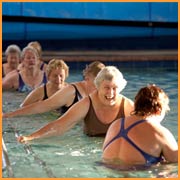Healthy active ageing: How to get active
 |
Healthy active ageing: How to get active |
Taking action to stay healthy and active as you get older helps improve your wellbeing and reduces your risk of falling. Our bodies are designed to be used and this becomes even more important as we get older.
Being physically active is essential for health and wellbeing and will also help you to stay independent. If you do have a fall, being fit will help minimise the impact and harm from such an event.
Essential elements of physical activity include strength, balance, endurance and flexibility. While age can affect your strength and balance, this can be improved by regular physical activity on most days of the week. It’s never too late to start. For more information about physical activity or to assess your individual situation, download:
- Ageing with vitality: Your everyday guide to healthy active living and Ageing with vitality: Workbook
- How to Stay On Your Feet® Checklist.
How much physical activity should I be doing?
The Australian Government has introduced physical activity recommendations specifically for older Australians, which state that older adults:
- should do some form of physical activity, no matter what their age, weight, health problems or abilities
- should be active every day in as many ways as possible doing a range of physical activities that incorporate fitness (endurance), strength, balance and flexibility
- should accumulate at least 30 minutes of moderate-intensity physical activity on most, preferably all, days
- who have stopped physical activity, or who are starting a new physical activity should start at a level that is manageable and gradually build up to the recommended amount, type and frequency of activity
- who continue to enjoy a lifetime of vigorous physical activity should carry on doing so into later life in a manner suited to their capability, provided recommended safety procedures and guidelines are adhered to.
Physical activity to prevent falls
Research shows that exercise programs including strength and balance can reduce falls rates in older people by 17%. Positive benefits to prevent falls were seen after doing two x two hour sessions of strength and balance exercises for 25 weeks. It is recommended that older people, with poor mobility, should perform balance activities 3 or more times per week and muscle-strengthening activities should be done involving major muscle groups, on 2 or more days a week (adapted from the WHO global recommendations on physical activity for health1.
1. World Health Organisation (WHO). Global recommendations on physical activity for health. 2010.
Why isn't regular walking enough to prevent falls in older people?
Walking is one of the most common physical activities undertaken by older people, and there is good evidence of a positive benefit from increased walking in terms of chronic disease prevention. However, current evidence shows that walking programs alone are ineffective in preventing falls. Walking has no impact on balance which may explain why walking programs alone do not reduce falls.2
2. Voukelatos A; Merom D; Sherrington C; Rissel C; Cumming RG; Lord SR, 2015, 'The impact of a home-based walking programme on falls in older people: the Easy Steps randomised controlled trial.', Age and Ageing, vol. 44, no. 3, pp. 377 - 383, http://dx.doi.org/10.1093/ageing/afu186
Are you ready to get active?
If you have been inactive for a while, or have a health condition, check with your doctor before you begin increasing your level of activity. To improve your level of physical activity, it’s best to get a professional to help you design a program specific to your needs.
- Keep yourself active - take action
